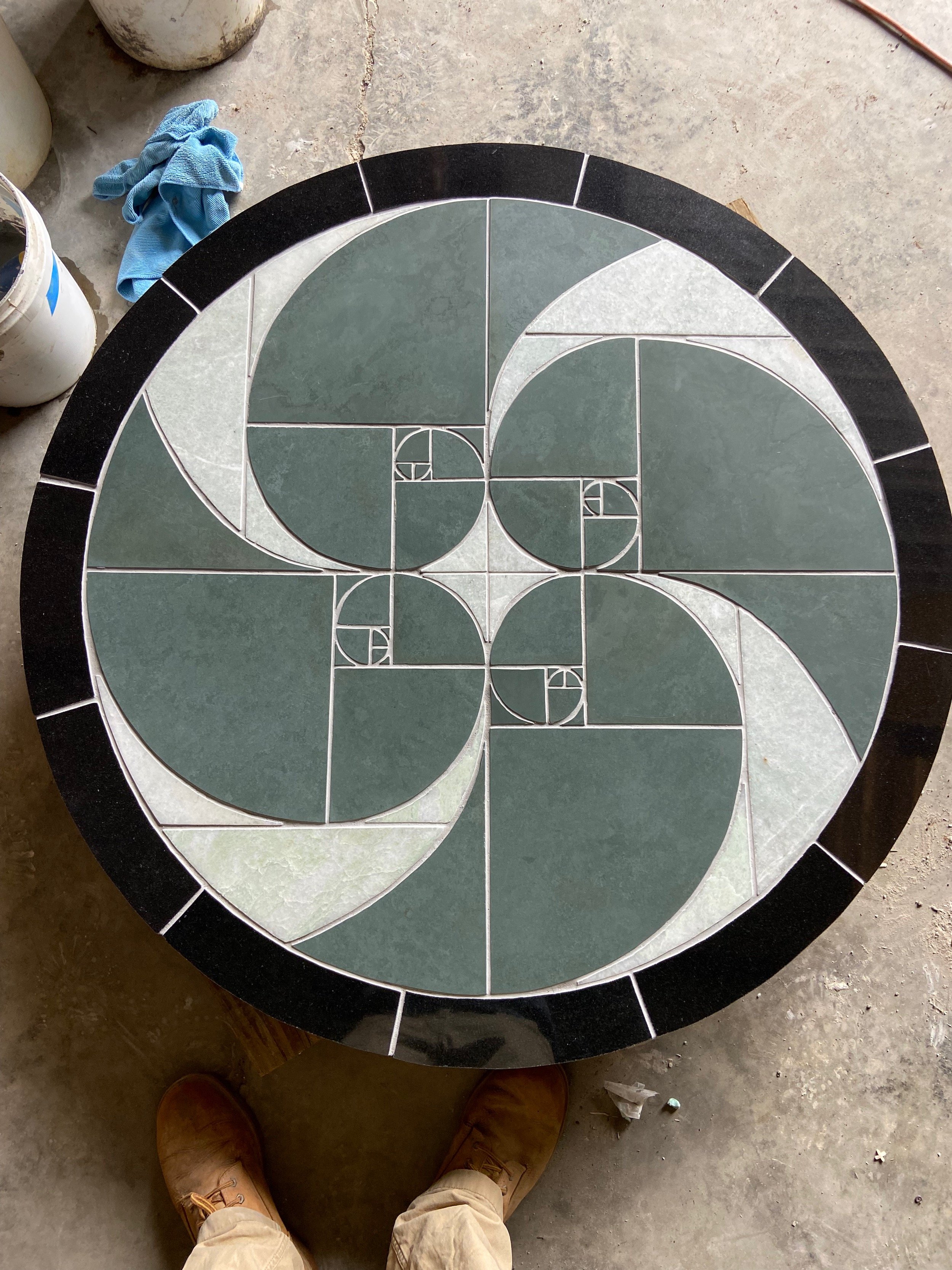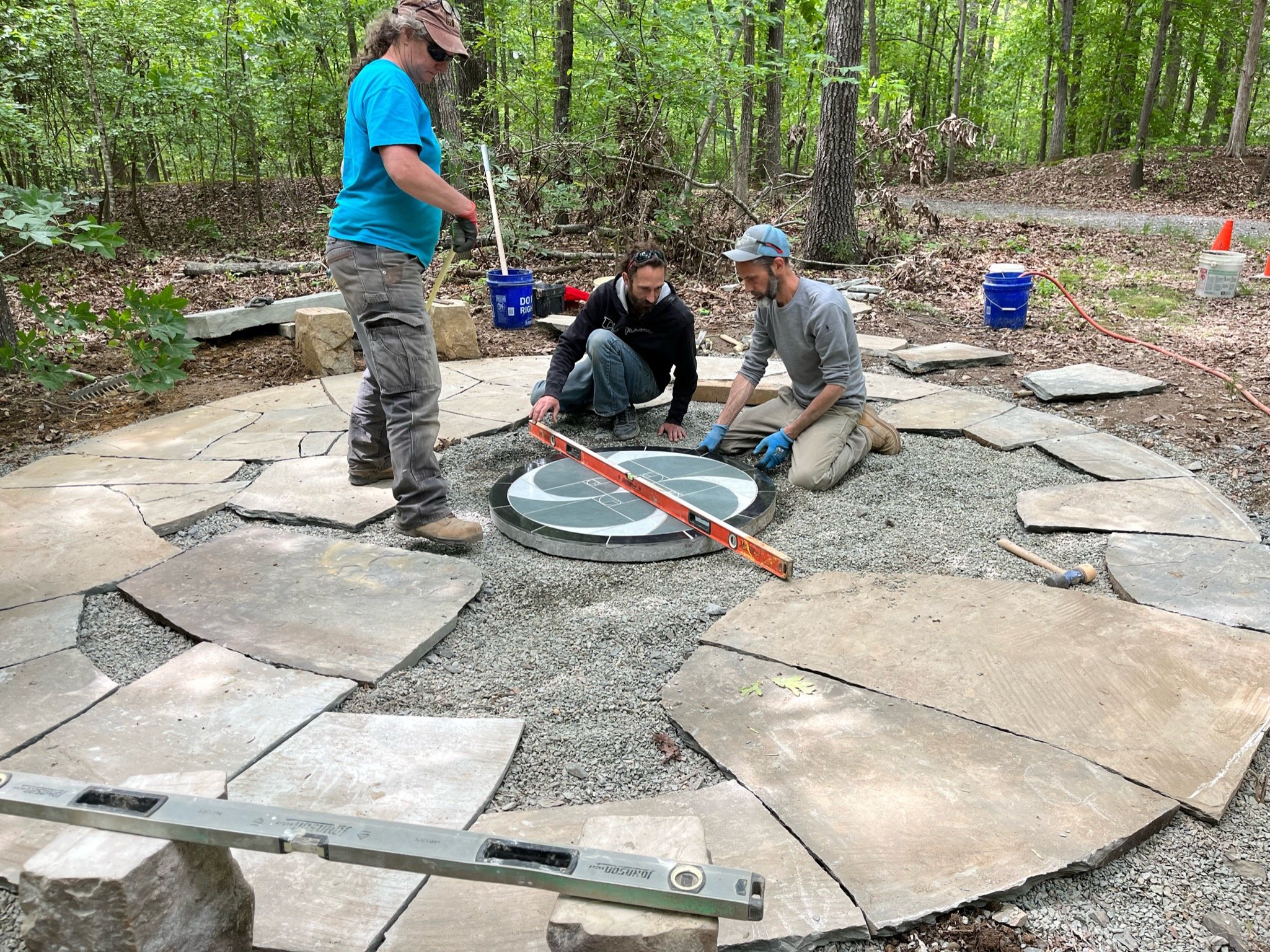Memorial Mosaic Patio
Hammerhead Stoneworks built a stone memorial mosaic patio for the Ironwoods neighborhood in Chapel Hill, NC. It honors the life of longtime resident Jim Kaiser. Commissioned by Jim’s family and the neighborhood Homeowners Association, the drystone patio sits in a clearing in the woods on community land everyone can use. While we were working there, a regular stream of residents (and their pups) wandered through the woodsy location.
The Memorial Mosaic Process
There were two major factors that we had to address to make this project a success: the design and the travel. Because this patio was intended as a memorial, the design phase was more involved than was typical. It also presented challenges because we are based in Asheville, but the project was sited in Chapel Hill.
Designing the stone project
Matthew Feldt of Ironwoods contacted me because of previous projects we had done together, including a neighborhood entry sign I built in collaboration with blacksmith Lynda Metcalfe. Matthew told me the neighborhood wanted to create a communal gathering space that celebrated the life of a long-time and well liked member of the community named Jim Kaiser. The HOA already had a site picked out and they knew that they wanted stone benches. Was I interested? Yes. Very much so. These are some of my favorite projects, where we are able to combine our structural stonework- in this case a patio and benches- with our detailed aesthetic work- a memorial mosaic.
Designing the memorial mosaic
This process was challenging because I did not know Jim personally and did not have a lot of access to his life story. I find that I do my best work, particularly with memorials, the better I know the subject. Little stories and life details are excellent jumping off points for creating a meaningful design.
I knew that Jim loved music and was an engineer. Good start, but I found all of my early sketches to be generic and clichéd. I want my memorial mosaics to be specific and connected to the subject in a meaningful way.
I was able to have a conversation over the phone with one of the Jim’s daughters. She told me about her Dad and I was able to put more pixels into my picture of him. She mentioned his lifelong fascination with mathematics and how he would play math games with her and her siblings. I talked about drawing Fibonacci sequences with my sons, and she connected to that idea. Capturing that love of mathematics and creativity through Fibonacci spirals became the guiding design principle of the memorial mosaic.
Designing a Fibonacci Sequence in Stone
I draw my designs in Adobe Illustrator. I like the freehand capabilities, though it can be harder to get precise geometry. A Fibonacci sequence is a series of numbers that begins 1, 1. To find the next number, you add the previous two. So that 1, 1 sums up to become 2. The sequence therefore is 1, 1, 2, 3, 5, 8, 13, 21, and so on. Laid out on a grid, the sequence creates a series of boxes. Drawing a quarter circle in each box, as they get larger and larger, creates a spiral. This design is found throughout nature: fiddlehead ferns, nautilus shells, the spiraling seed patterns of a sunflower. It was important to scale the design so that it fit the space and was legible as a Fibonacci sequence.
Designing the patio
I like a circular design for a memorial mosaic. The patio is a self-contained unit. It is not adjacent to a house or otherwise responding to boundaries or parameters. A circular patio is more inclusive and unifying. With a central mosaic design, it becomes a mandala, representing the cycle of life. I like to work with circular designs as well because they have no top or bottom, no up or down. However you see it, it’s right.
Fabricating the mosaic
We built the Fibonacci mosaic in our Asheville shop. Hammerhead artist-mason Jonathan Frederick did the majority of the stone cutting work on this particular mosaic. This style of mosaic is called opus sectile, and is comprised of larger pieces, cut into specific shapes. We cut our mosaics on tile saws. The fine points on the lighter stones were most challenging to cut.
The mosaic is made of three different types of stone tiles. The dark green Fibonacci pieces are Jade slate. The light green background stones are Ming green marble. The outer black band is made of absolute granite. These tiles are installed on a 2 inch thick, concrete disk that is made of high psi concrete and wire re-mesh. Once the mosaic memorial was completed, we were ready to travel
Traveling for stonework projects
Hammerhead Stoneworks is based in Asheville, North Carolina, but we travel for projects across the region. We have installed school mosaics in Virginia, public art in Florida, and patios in Atlanta. The logistical challenges of doing stonework so far from home are primarily in site planning and finding the right supplies.
Assessing the stonework site
It is important to assess the site of proposed stonework in person. Modern technology makes it easier to share information, images, and even videos of a construction site. Even so, there are so many details that can only be seen and understood in person. A few weeks before we were scheduled to install the patio and mosaic, I visited Chapel Hill. While I was there, I explored the project site with Matthew, my HOA contact. Using a can of spray paint, we marked out on the ground where the patio and benches would be. Marking the patio in advance like this also gave the neighborhood a chance to see the scale of the project and get a feel for how we would transform the space. While visiting the site, I determined where to have our stone delivered, how to bring our supplies in (the project was in the woods after all) and all the other little details that smoothed the way for the construction process.
Finding stone for out of town jobs
These days it’s easy to find a big box hardware store just about anywhere. Sourcing natural stone can be a bit more challenging. Most communities have a stone yard somewhere, but inventory can vary dramatically. Do they have the particular stone I’m looking for? Is it good quality? Is there enough to see the project through? While in Chapel Hill, I visited Scott Stone in neighboring Mebane. Territory Manager Nathan Newlin was incredibly helpful, showing me through their whole yard and helped me tag the stone I needed. I found several pallets of excellent quality Pennsylvania full color and three gray sandstone slabs to serve as bench tops. Nathan was especially helpful in setting up a delivery, so the stone would be there when we were ready to get started. They even sent over a few bags on concrete, carefully wrapped in plastic to withstand the weather. Scott Stone was instrumental in making this happen. I appreciate how they helped us, even though we had never worked together before.
Bring what you need
We made a lot of lists before we left Asheville. We brought every tool we guessed we might need- and some we didn’t need at all. We brought the bench bases, which we had already prepared. We had our power carrier- a tracked wheelbarrow- to bring the stone and gravel into the site. We even brought decorative gravel, to be swept into the joints when the patio was done.
Luckily, the mosaic was already in Chapel Hill; I brought it with me when I went to assess the site. There was no room for it on either of the trucks!
Installing the patio
The patio installation went very smoothly. As two of the crew built the patio, the other two set the benches, digging in the bases and anchoring them in concrete. Once the entire perimeter of the patio was set, we installed the mosaic, making sure to center it carefully.
Working out of town
I’m a homebody, but I like the occasional work trips. I enjoy the intense focus, the challenge of logistics, and the camaraderie. This trip we stayed in a VRBO and got to dine well in Chapel Hill and Carrboro. We found a classic hardware store too, Fitch Lumber & Hardware, with a most excellent hammer-themed logo, because of course, we forgot something. And after a trip like this, it’s always great to get back to the mountains.
The Finished Memorial Mosaic Patio
We installed this mosaic in early May 2023. Shortly thereafter, it was dedicated and the HOA used the patio for its monthly meeting. It’s very satisfying to create works of art like this, that can engage and be useful to an entire neighborhood. And I hope that this memorial mosaic helps to keep the spirit of Jim Kaiser on people’s minds as they enjoy the space.







